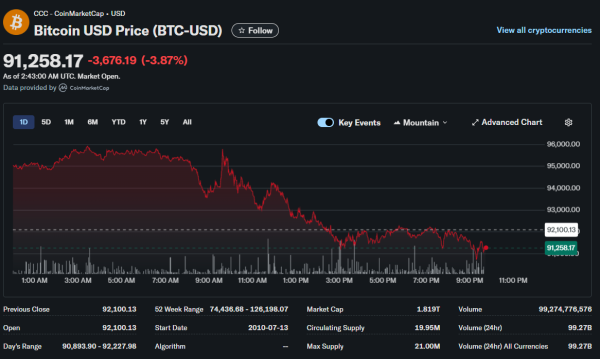The second-largest cryptocurrency by market value dropped below a key price threshold during weekend trading as digital assets broadly retreated. Ether changed hands around $3,066 late Sunday evening, marking a decline exceeding 3% across the previous day. Trading data shows the token pierced through $3,100 on major exchanges, its first venture below that mark in nearly two weeks.
A financial expert at LFTrade investigates what recent price action and investment fund activity suggest about changing attitudes toward Ethereum’s native token.
Critical Level Breached
The cryptocurrency fell through $3,100 during Sunday afternoon hours on prominent trading platforms according to market tracking services. This development holds importance for market participants who monitor such round-number price points as indicators of sentiment shifts. These psychologically significant levels frequently attract concentrated trading interest.
Digital currency markets experienced widespread weakness affecting major tokens simultaneously over the weekend. Bitcoin likewise encountered selling momentum, shedding roughly 4% during comparable periods. The synchronized price movements across leading cryptocurrencies point toward macro market dynamics rather than token-specific developments.
Weekend sessions characteristically feature lighter trading volumes compared to weekday activity in crypto markets. This reduced participation can occasionally magnify price swings. Yet the persistent nature of Ether’s decline indicates authentic selling interest beyond mere liquidity-related volatility.

Investment Product Withdrawals Mount
Timothy Peterson, who manages investments and researches digital assets at Cane Island Alternative Advisors, offered valuable perspective on Ether’s recent struggles. His analysis revealed that exchange-traded funds holding spot Ether experienced net investor exits during four of the preceding five weeks. These withdrawals represented roughly 7% of the original capital that investors had committed to these financial products.
This cost-basis measurement tracks the aggregate initial investment amounts flowing into an ETF, distinct from any profits or losses accumulated subsequently. The figure illustrates how much core capital from committed holders supports a fund. It offers insight into the resolve of established participants versus transient traders.
Peterson drew comparisons with Bitcoin’s investment product performance across identical timeframes. Exchange-traded funds holding Bitcoin saw approximately 4% of cost-basis capital withdrawn. This comparatively smaller proportion suggests a notable difference in investor confidence between the two dominant cryptocurrencies presently.
Perceived Risk Differential Widens
The gap between ETF withdrawal rates for Ether versus Bitcoin carries meaningful implications regarding how institutional and sophisticated investors assess these digital assets currently. Peterson directly concluded that available evidence shows market participants consider Ether the higher-risk option relative to Bitcoin at present. This marks a significant development in comparative risk assessment.
Bitcoin has historically maintained recognition as the most established and stable major digital currency. Its longer operational track record, clearer regulatory treatment, and wider institutional adoption typically position it as the safer cryptocurrency investment. However, current ETF flow disparities suggest this risk differential has expanded notably.

Measurement Methodology Matters
The cost-basis approach delivers advantages compared to simpler headline inflow and outflow figures dominating typical coverage. Conventional flow statistics can be substantially affected by near-term volatility and temporary positioning adjustments. These week-by-week variations don’t necessarily signal fundamental shifts in long-term participant conviction.
Examining redemptions as a proportion of original capital commitments filters out market noise more effectively. When withdrawals climb relative to this foundational investment baseline, analysts can recognize genuine confidence erosion among established holders. This proves more illuminating than absolute dollar outflow amounts.
The present 7% withdrawal rate for Ether ETFs measured against cost-basis capital indicates meaningful capital extraction from committed allocations. This doesn’t reflect panic but rather a deliberate exposure reduction by investors reconsidering their digital asset positions. The 4% equivalent figure for Bitcoin demonstrates relatively stronger conviction persistence for the pioneering cryptocurrency.
Trading Dynamics Evolve
Ether’s behavior around the $3,100 threshold will probably draw heightened scrutiny from technically-oriented traders moving forward. Penetrations beneath important support zones frequently activate supplementary automated selling as protective stop orders execute. Whether purchasing emerges to stabilize lower pricing will help establish if this constitutes a temporary adjustment or directional shift.
The wider cryptocurrency marketplace remains subject to macroeconomic influences encompassing interest rate projections and overall risk tolerance. Federal Reserve policy ambiguity continues generating obstacles for growth-focused investments including digital currencies. Any further restrictive messaging from monetary policymakers could intensify downward crypto pressure.
Near-Term Path Unclear
Market observers will carefully track whether Ether ETF redemptions stabilize or intensify during upcoming weeks. Persistent heavy withdrawals would strengthen narratives of deteriorating confidence. Alternatively, steadying flows might imply the most severe sentiment adjustment has concluded.
Technical price behavior around crucial thresholds will deliver important directional signals. Should Ether encounter difficulty recovering above the $3,100 benchmark, it might signal additional downside exposure. A prompt rebound beyond this level could suggest the weekend weakness represented a fleeting pullback rather than trend reversal.
The confidence disparity between Ether and Bitcoin emphasized through Peterson’s research constitutes a phenomenon meriting continued observation. If this differential maintains or expands, it might influence how participants construct their cryptocurrency holdings prospectively. Many investors traditionally maintain stakes in both tokens, yet evolving risk views could modify these distribution choices.






